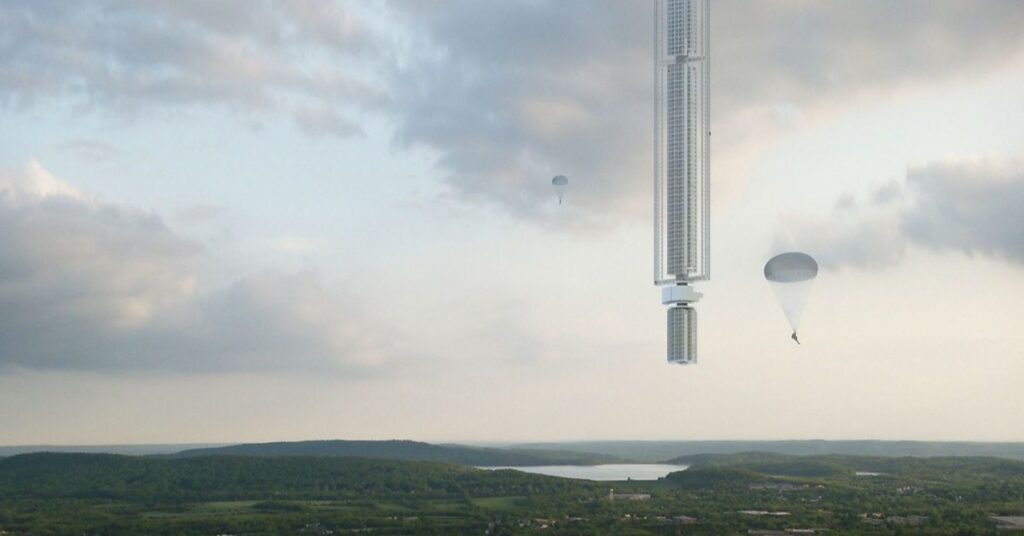Imagine waking up above the clouds, having breakfast over Dubai, enjoying lunch above the African savanna, and falling asleep while floating above New York City—all in the same day. No, this isn’t a scene from a sci-fi movie. This is the surreal vision of the Analemma Tower: the world’s first skyscraper suspended from space. In a bold leap of imagination and innovation, the Analemma Tower concept challenges every convention of architecture, engineering, and human habitation. Designed by the New York-based Clouds Architecture Office, this proposed skyscraper wouldn’t be built from the ground up—it would hang from an asteroid tethered to space, orbiting the Earth. As outrageous as it sounds, this ambitious concept taps into emerging technologies, existing science, and a willingness to redefine humanity’s relationship with space and Earth. What is the Analemma Tower? The Analemma Tower is a conceptual orbital skyscraper that would be suspended from a satellite or asteroid placed in geosynchronous orbit—a stable path approximately 50,000 kilometers above Earth. It would remain in constant motion along a figure-eight trajectory (called an analemma), looping daily across key cities like New York City, Dubai, and Panama City. Instead of building toward the sky, this tower would be built from the sky downward—a reverse engineering marvel. Key features of the concept include: The Vision Behind the Tower According to Clouds AO, the tower was conceived in response to two big ideas: Instead of permanently occupying Earth’s surface, the Analemma Tower offers a hybrid lifestyle that combines both terrestrial and extraterrestrial …
Analemma Tower: A Skyscraper Suspended from Space – Architecture’s Boldest Leap Yet

Imagine waking up above the clouds, having breakfast over Dubai, enjoying lunch above the African savanna, and falling asleep while floating above New York City—all in the same day.
No, this isn’t a scene from a sci-fi movie. This is the surreal vision of the Analemma Tower: the world’s first skyscraper suspended from space.
In a bold leap of imagination and innovation, the Analemma Tower concept challenges every convention of architecture, engineering, and human habitation. Designed by the New York-based Clouds Architecture Office, this proposed skyscraper wouldn’t be built from the ground up—it would hang from an asteroid tethered to space, orbiting the Earth. As outrageous as it sounds, this ambitious concept taps into emerging technologies, existing science, and a willingness to redefine humanity’s relationship with space and Earth.
What is the Analemma Tower?
The Analemma Tower is a conceptual orbital skyscraper that would be suspended from a satellite or asteroid placed in geosynchronous orbit—a stable path approximately 50,000 kilometers above Earth. It would remain in constant motion along a figure-eight trajectory (called an analemma), looping daily across key cities like New York City, Dubai, and Panama City.
Instead of building toward the sky, this tower would be built from the sky downward—a reverse engineering marvel.
Key features of the concept include:
- Suspension from space using ultra-strong cables
- Daily orbiting loop, offering a new view of Earth every hour
- Self-sustaining systems for solar power, water harvesting, and waste recycling
- Zones dedicated to work, play, sleep, worship, and agriculture
The Vision Behind the Tower
According to Clouds AO, the tower was conceived in response to two big ideas:
- Human migration toward cities and vertical living
- The growth of off-Earth real estate development
Instead of permanently occupying Earth’s surface, the Analemma Tower offers a hybrid lifestyle that combines both terrestrial and extraterrestrial influences. The proposal imagines a future where we don’t just build upwards—we attach our habitats to the stars.
In a statement, the architects said:
“Through the course of design and development, we realized that we could harness space-based construction and real estate, freeing us from traditional architectural constraints.”
How Would It Work?

1. Tethering to an Asteroid
- A captured asteroid would be repositioned into geosynchronous orbit over Earth.
- High-tensile cables would descend from the asteroid, anchoring the skyscraper in mid-air.
While this sounds fantastical, NASA is already researching asteroid redirect missions as part of its planetary defense and deep space exploration programs.
2. Orbiting Trajectory
- The tower would trace a figure-eight path across the Earth’s surface, following a geosynchronous orbit.
- The orbit would take it over select major cities, creating a moving habitat with scheduled overhead times.
For instance:
- Dubai at dawn
- Africa by noon
- New York in the evening
3. Energy & Sustainability
- Power would be generated by space-based solar panels, which receive uninterrupted sunlight.
- Water would be collected from atmospheric condensation and possibly rain when closer to the Earth’s surface.
- A closed-loop water and waste system would ensure minimal environmental impact and self-sufficiency.
Design Breakdown: Inside the Analemma Tower
The Analemma is designed as a modular vertical city, with different segments of the tower dedicated to different functions:
- Top Sections (40,000+ meters):
- Living and sleeping areas
- Stunning views of the curvature of Earth
- Isolation from noise, pollution, and even gravity
- Mid Sections (20,000–40,000 meters):
- Office spaces
- Spiritual zones (meditation, chapels, etc.)
- Agricultural modules with high-yield crops
- Lower Sections (Earth proximity):
- Retail, recreational, and public access areas
- Entry and exit via drones, aircraft, or orbital elevators
The Engineering Challenges
While the vision is audacious, building the Analemma Tower faces monumental challenges:
- Tethering a skyscraper to an asteroid is currently beyond our engineering capabilities.
- Cable material strength: We’d need materials stronger than current carbon fiber or Kevlar—perhaps graphene or carbon nanotubes.
- Thermal and pressure variations from Earth’s atmosphere to near space would be extreme.
- Motion sickness & psychological effects of living in a moving tower could pose health issues.
- Rescue, security, and communication systems would need to be radically redesigned.
Despite these hurdles, the concept isn’t just fantasy—it’s a provocation meant to push engineers and designers to imagine new boundaries.
Is It Even Possible?
Today? No. Tomorrow? Maybe.
NASA and ESA are already working on asteroid manipulation and orbital habitats. Companies like SpaceX are pioneering commercial space transport. Meanwhile, Earth-bound architects are building ever taller and more ambitious structures—like the Jeddah Tower and Tokyo’s Sky Mile Tower concept.
The Analemma Tower may be a few decades (or centuries) away, but it represents a philosophical shift—one where architecture is not bound by gravity, property lines, or traditional construction.
Why It Matters: Beyond Imagination
The Analemma Tower matters not because it’s being built today, but because it asks the right questions about the future of human living:
- What if we didn’t have to choose one city to live in?
- What if architecture could move with us?
- Can we build sustainably without touching the Earth?
- Is the future of design upward, or outward—into space?
In an age where climate change, overpopulation, and urban density are pressing concerns, such radical ideas push us to reimagine solutions that go beyond the surface—literally.
Conclusion: Earth’s First Hanging Habitat in the Sky
The Analemma Tower is a monument to possibility—a daring proposal that blends science, design, and imagination. It may never materialize in the exact form presented, but its essence will likely live on in future orbital habitats, floating cities, and space architecture.
Whether seen as an architectural fantasy or a blueprint for tomorrow, one thing is clear: the sky is no longer the limit.


